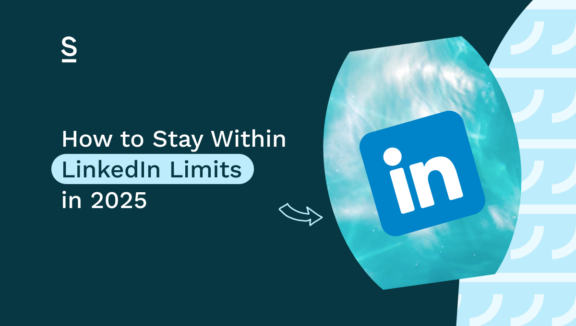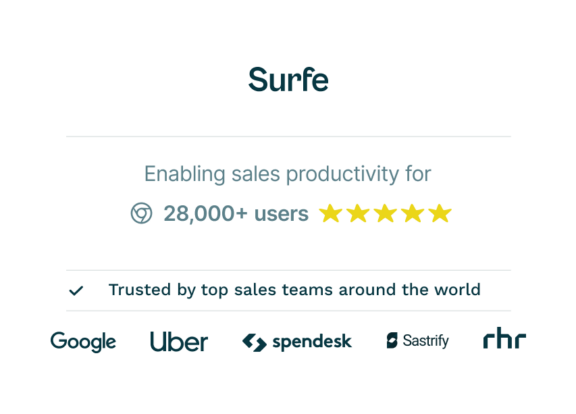How to Stay Within LinkedIn’s Limits in 2025

If you work in sales, chances are you have a love-hate relationship with LinkedIn. On the one hand, it’s undoubtedly one of the most powerful tools for connecting with new prospects and building a professional network. But when you spend hours every day trawling through the depths of the platform, it can be overwhelming. So, you call on automation tools to lighten some of the admin load and make your life a little easier.
However, as more users turn to automation to maximize their LinkedIn efforts, some run the risk of hitting LinkedIn’s usage limits— sometimes even triggering account suspensions. If you’re one of the many professionals who use LinkedIn for lead generation and outreach, understanding how to stay within LinkedIn’s limits is crucial to keeping you tapped in to your pool of prospects.
This article will help you understand LinkedIn’s limitations, why they exist, and how to avoid violating them, ensuring your account stays safe and productive in 2025 and beyond.
In this article, we’ll cover:
Why LinkedIn Enforces Limits
As the world’s leading professional networking platform, LinkedIn operates on a delicate balance between user engagement and platform integrity. To maintain a high-quality user experience, LinkedIn enforces strict usage limits on certain actions to prevent spam, malicious behavior, and automated misuse. Without these safeguards, LinkedIn could quickly become flooded with bots, irrelevant content, and spam messages, driving away its core user base of professionals seeking genuine connections.
These limits are especially crucial for businesses and professionals engaged in outreach and lead generation. Violating them— even unintentionally— can lead to account restrictions, which in turn can harm your reputation and limit your ability to connect with potential leads.
Preventing Spam and Ensuring Security
LinkedIn is built around authentic, human-driven interactions. Excessive use of automation tools can disrupt this balance and compromise the experience for other users. For example, bulk messaging campaigns and mass profile viewing can feel spammy and intrusive to recipients. LinkedIn also takes security seriously, so behaviors that resemble those of bots— like rapid profile views, mass connection requests, or logging in from multiple IP addresses— are red flags for LinkedIn’s algorithms.
By enforcing these limits, LinkedIn ensures the platform remains a safe space for professionals to connect without fear of being bombarded by unsolicited, irrelevant, or malicious content. For this reason, understanding and adhering to LinkedIn’s limits is not just a matter of following the rules: it’s about being a respectful member of the LinkedIn community.
Common Actions That Trigger Account Restrictions
While LinkedIn doesn’t always publish the exact figures for its usage limits, experience and feedback from users offer some general guidelines on what activities are considered risky. Below are some common actions that can lead to account suspensions if overdone:
1. Profile Views
Viewing profiles is a key part of LinkedIn networking, whether it’s checking out potential leads or scoping out new business opportunities. However, viewing too many profiles in a short period can raise a red flag. This often happens when users open multiple tabs and view several profiles rapidly.
- Safe limit: No more than 500 profile views per day.
Even if you’re manually browsing profiles, exceeding 500 views in a day may make LinkedIn suspicious that you’re using an automation tool. Spread your profile views across the week to stay safe.
2. Connection Requests
While growing your network is essential, sending too many connection requests—especially to people you don’t know—can quickly trigger LinkedIn’s anti-spam systems. LinkedIn wants to ensure that connections are meaningful and not just a numbers game.
- Safe limit: Keep connection requests below 100–150 per week.
If you’re sending connection requests to people you’ve never met, LinkedIn may view it as a form of unsolicited outreach. It’s always best to personalize requests and avoid using automation to send large volumes of them at once.
3. Cold Outreach Messages
Messaging is where many LinkedIn users inadvertently push the platform’s limits. Sending too many cold outreach messages (especially to people who haven’t accepted your connection request or don’t know you) can result in restrictions.
- Safe limit: No more than 100–150 unsolicited messages per week.
LinkedIn monitors messaging behavior closely, especially unsolicited outreach. Sending the same message to too many recipients can flag your account for spam-like activity. Personalize your messages and space them out to avoid being seen as a spammer.
4. Repetitive Actions
LinkedIn’s algorithms also flag repetitive behaviors. For instance, sending the same message to dozens of recipients or repeatedly taking the same action (such as endorsing profiles or liking content) in quick succession may raise suspicions.
- Best practice: Vary your actions, personalize your messages, and avoid repeatedly performing the same task in bulk.
5. Automation Tools
Automation tools can be helpful, but they can also get you into trouble if they perform bulk actions, like scraping data of many profiles at once or sending mass messages. Tools like Surfe are designed with these limits in mind, so you won’t encounter issues as long as you use them responsibly. Surfe doesn’t engage in bulk scraping or automated actions, making it a safer choice for CRM integration. And you can still send message templates for LinkedIn safely.
- Best practice: Avoid using LinkedIn automation tools that scrape data en masse, send mass connection requests, or perform any bulk actions without manual intervention.
6. Multiple Logins from Different IP Addresses
If LinkedIn detects that your account is being accessed from multiple IP addresses or devices in a short span, it may assume your account has been compromised or is being used by unauthorized third parties. This can happen if you frequently switch between VPNs or work from multiple locations.
- Safe limit: Stick to one or two consistent IP addresses for logging into LinkedIn.
Logging in from several different locations or devices in a short time window can raise security concerns. It’s best to avoid using multiple VPN protocols or switching devices too frequently when accessing LinkedIn.
How to Stay Within LinkedIn’s Limits
Avoiding account restrictions comes down to a combination of awareness and moderation. Below are some tips to help you stay within LinkedIn’s limits and avoid triggering their algorithms.
1. Avoid Overusing Automation
Automation tools can save time, but it’s important to use them carefully. LinkedIn’s limits are designed to prevent bulk automation that feels robotic or spammy. With Surfe, you can sync data from LinkedIn to your CRM without triggering LinkedIn’s anti-automation rules because Surfe doesn’t perform any scraping or bulk actions. Just remember when transferring data from LinkedIn to your CRM to stick to the limits we lay out in this article.
- Pro tip: Always use automation tools like Surfe in moderation. Be mindful of LinkedIn’s limits when using any additional tools that automate profile views, connection requests, or messages.
2. Moderate Your Activity
A key way to avoid raising red flags is to spread your actions out over several days. For example, rather than viewing hundreds of profiles in a single day, aim to browse 50–100 profiles daily. Similarly, space out your connection requests and messages over the week rather than sending them all in one burst.
- Best practice: Set daily goals rather than weekly ones to keep your actions evenly distributed.
3. Avoid Opening Multiple Tabs
Opening multiple LinkedIn profiles in different browser tabs at once can give the appearance of automated browsing, especially if you view too many profiles too quickly. This can lead to temporary account restrictions.
- Best practice: Avoid the temptation to multi-tab LinkedIn profiles. Stick to a single window or browser tab to view profiles one at a time.
4. Keep Your IP Address Consistent
Logging in from a stable and consistent location or static IP address is one of the simplest ways to keep your LinkedIn account safe. Avoid frequently switching between VPNs or logging in from multiple devices within a short period.
- Best practice: Stick to using LinkedIn on your primary device and avoid switching between different IP addresses or devices in quick succession.
5. Monitor Your Usage
LinkedIn monitors user behavior closely, even for manual actions that seem normal. If your account consistently performs the same action too frequently, LinkedIn may flag it as automated activity. Keep track of your daily actions and vary them to avoid being flagged.
- Pro tip: Maintain a log of your daily actions (profile views, connection requests, messages) to ensure you’re staying within safe limits.
Consequences of Violating LinkedIn’s Limits
So what happens if you actually end up infringing LinkedIn’s limits? The fallout can be severe, especially if you’ve got imminent deals on the line.
- Temporary Account Suspension: LinkedIn may temporarily restrict your ability to send messages, view profiles, or send connection requests.
- Permanent Account Restriction: Repeated violations can lead to a permanent ban, meaning you’ll lose access to your account and all of your valuable connections and data.
- Damage to Your Professional Reputation: Being flagged as a spammer or automating too many actions can harm your professional reputation. Your contacts may be less inclined to engage with you if they believe your actions are not genuine.
Let’s Wrap It Up!
Staying within LinkedIn’s limits is all about balance. The platform is built to foster meaningful, human interactions, and its limits are designed to protect that goal. For Surfe users, it’s important to leverage the efficiency and CRM integrations that Surfe provides while being mindful of LinkedIn’s restrictions. Spread your actions over several days, avoid using too many automation tools, and be mindful of how LinkedIn perceives your behavior.
By following these best practices, you can ensure that you’ll keep your account in LinkedIn’s good books. So you can continue having those all-important conversations to help you smash your sales targets.

Want to safeguard your LinkedIn account from limitations?
Surfe helps you prospect at scale without the worry of account restrictions.
Frequently Asked Questions (FAQs)
How many profile views can I safely perform per day?
The general safe limit is around 500 profiles per day. Exceeding this can flag your account for unusual activity.
Can I use multiple automation tools on LinkedIn?
It’s risky to use multiple automation tools. Surfe is safe because it doesn’t perform bulk actions, but using additional tools may increase the chance of account restrictions.
How many connection requests can I send per week?
It’s best to keep it under 100–150 requests per week to avoid triggering LinkedIn’s spam filters.
What happens if I violate LinkedIn’s limits?
Violations can lead to temporary suspensions or, in serious cases, permanent account restrictions.


